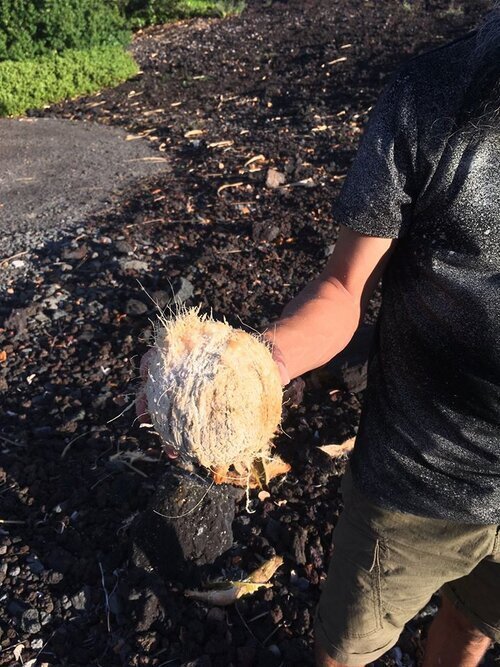In most parts of North America and Europe, the only coconuts that you can easily find are about softball-sized with a hard, hairy, brown shell. This is the actual seed of the coconut palm- normally it is surrounded by a tough, fibrous fruit colloquially known as the husk. The naturally-buoyant husk protects the seed as it falls from the tree and permits it to float for a time on water. It is generally removed to lower shipping costs when sent to foreign markets, resulting in the hard, bare nuts we are used to seeing. More recently, white ‘drinking coconuts’ have become available, but these nuts are too immature to be used to grow a coconut palm.
A coconut will sprout if it is viable (there’s a living embryo capable of growth inside) and when certain conditions are met – sufficient warmth and sufficient moisture. The easiest way to grow a coconut from seed is to get a fully-mature coconut with the husk still in place. The husk provides an ideal regulatory system for wicking moisture to the seed – unlike most seeds, the coconut is best left in the fruit (unhusked) when planted.
A whole coconut can be left to float on warm water overnight and then partially buried in moist sand or soil, leaving anywhere between half and three quarters of the coconut exposed. Angling the end that was attached to the tree slightly upward is best. Now keep the coconut’s substrate moist and warm (between around 75f and 90f), and in a few months, a little, green sprout should appear.
Coconuts can sometimes grow for a while with no soil at all.
If you can only get coconuts that have had the husks removed, you can still get them to grow, although it is more challenging. Select a coconut that feels heavy and has a good amount of water inside. One of the eyes of the coconut is softer than the other two; this is where the sprout emerges. Soak the coconut in warm water overnight. Bury your coconut in damp sphagnum moss at least halfway, if not most of the way into the moss. The soft eye should be just about level with the surface of the moss. Covering the coconut and pot with a plastic bad to keep humidity levels up can help. Keep the moss damp, and with time and warmth, a little, green sprout should appear. If you can’t get sphagnum moss, damp peat or sand will also work, but I’ve had the most success with sphagnum, likely due to its antimicrobial properties. With a coconut still in its husk, once the sprout forms, you can put the seedling directly into full sun. With a husked coconut, it’s better to gradually uncover it to expose it to air and sun.
A freshly-husked Hawaiian coconut.
Once your coconut seedling grows its third leaf, it should be potted into rich, easily-draining soil if you are growing it in a container. If you are planning to plant it in your garden, coconuts grow best in moist, well-drained soil, but can grow in both rich and poor soils. The coconut tree will die if exposed to temperatures below freezing for a short time or temperatures below about 60f for extended periods. The coconut palm can be challenging to grow in climates unsuited to them, even indoors. They do, however, make for a beautiful and very interesting houseplant for a sunny window.
Coconut seedlings grown from unhusked nuts.
There is no need to fertilise your coconut seedling for the first two years of its life as it will still have plenty of nutrients from the seed. Afterward, they grow best with sufficient fertiliser. Outdoors, coconuts tend to be fairly pest-free, but indoors they can suffer from spider mite and scale infestations. These can be washed away with soapy water, plus a toothbrush for scale. In warm climates, the coconut palm grows rapidly, growing a new leaf about once per month. In colder climates, expect much slower growth. If you have a suitably-sunny, warm window, you can enjoy your coconut palm for years to come indoors. When grown outdoors in the tropics, a coconut palm can live to be a century or older.
Coconuts are a challenge to grow indoors or out in non-tropical places, especially if you are sprouting husked coconuts. When they struggle, it is usually due to too little sunlight or insufficient warmth. But unlike what is popularly believed, coconuts bought from the grocery store can indeed grow into a beautiful, tropical palm on your own sunny windowsill.
A husked coconut just beginning to sprout.
~The Wandering Weasel~


